San Francisco National Cemetery
Introduction
Text-to-speech Audio
Images
San Francisco National Cemetery (image from Historic Markers Database)
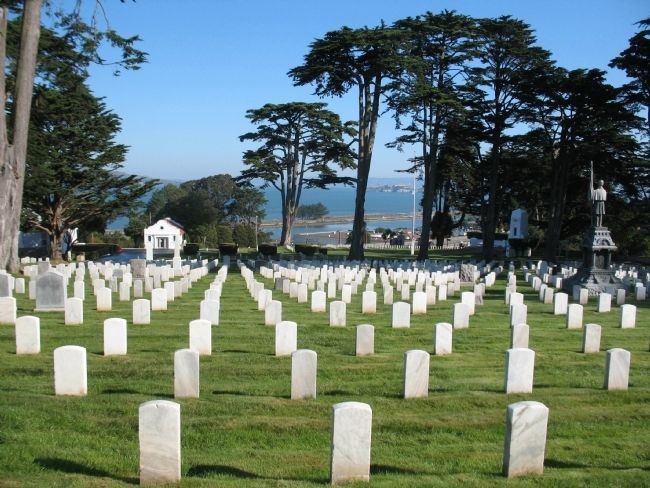
Cemetery gates (image from Historic Markers Database)
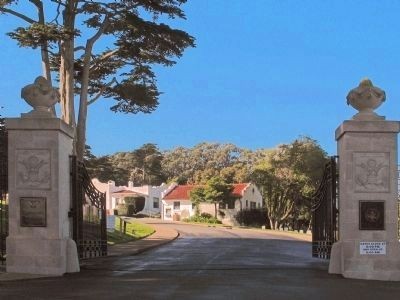
Cemetery office (image from Historic Markers Database)
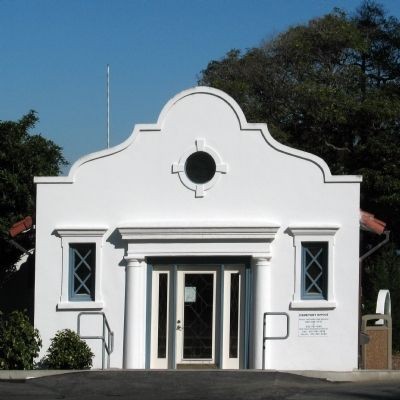
San Francisco National Cemetery historic marker (image from Historic Markers Database)
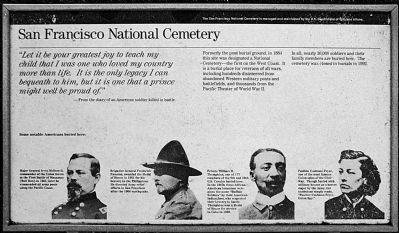
U.S.S. Oregon Marine Corps Memorial marker in San Francisco National Cemetery (image from Historic Markers Database)
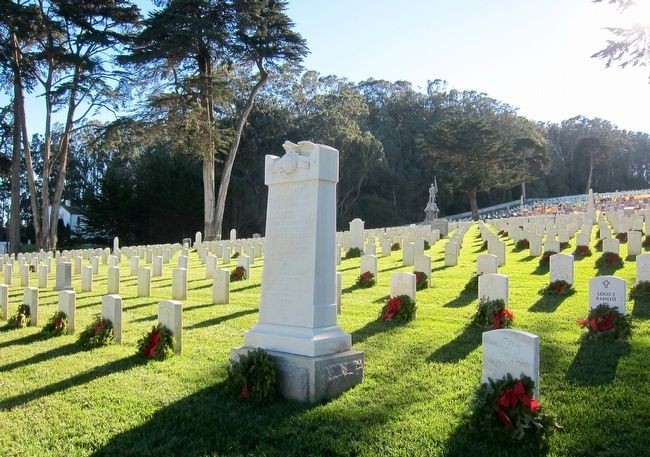
U.S.S. Oregon Memorial marker in San Francisco National Cemetery (image from Historic Markers Database)
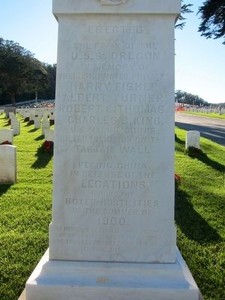
Station #17 Marker
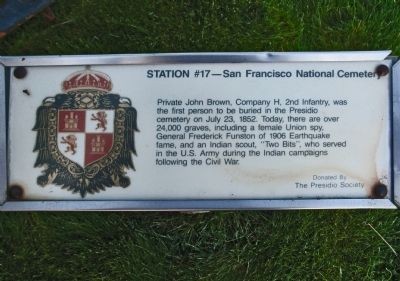
Backstory and Context
Text-to-speech Audio
The Presidio was established by the Spanish as a fort to defend the San Francisco Bay. The first settlers, a group of forty families from Mexico, arrived in 1776 and built a small village near Funston Avenue. After 1821, the Presidio was controlled by Mexico, but was virtually abandoned by 1835 as soldiers moved north to Sonoma. During the Mexican-American war (1846-1848), the Presidio was occupied by the United States Army.
The fort became a base for U.S. soldiers fighting Native Americans in California and its neighboring states, Oregon, Washington, and Nevada in the 1850s, and for the Union Army in the 1860s. A post cemetery was established, its first known interment in 1854; this was the humble beginning of what is now known as the San Francisco National Cemetery. The Presidio was expanded during the Indian Wars of the 1870s and 1880s, and became a major military base for Pacific expansion by the United States. Colonel George P. Andrews petitioned for the West Coast's first National Cemetery, which was designated on December 12, 1884, originally consisting of less than ten acres of land.
The first interments at the San Francisco National Cemetery, aside from the graves already present from the post cemetery years, were reinterred from abandoned military cemeteries at forts and camps along the coast and the Western frontier. During the 1890s, two monuments were erected, one to the Grand Army of the Republic (a fraternal organization of Union Army veterans) and one to the Pacific Garrison (Dedicated to the regular Army and Navy of the United States of America by The Pacific Coast Garrisons. Memorial Day 1897).
In 1900, the U.S.S. Oregon Memorial Marker was erected in the National Cemetery, honoring U.S. Marines Harry Fisher, Albert Turner, and Robert E. Thomas, Charles B. King, who died in the Boxer Rebellion in Peking, China. A concrete rostrum for official services was erected in 1915, and a mortuary chapel in 1921. The cemetery was reoriented toward the west in 1929, and the building which serves as the cemetery office was remodeled to Mission Revival style. In 1932, the National Cemetery expanded to 28.34 acres (its current size). Two years later, all unknown remains were disinterred and combined into one grave, marked by the Monument to the Unknown Dead.
The San Francisco National Cemetery houses approximately 30,000 burials, all veterans and the families of veterans. Among its interments are Buffalo Soldiers, Union spy Pauline Cushman Fryer, Sarah Bowman (who volunteered medical aid to Zachary Taylor's troops during the Mexican-American War), and many Medal of Honor recipients:
First Sergeant William Allen (Indian Campaigns), Company I, 23rd U.S. Infantry. Turret Mountain, Ariz., March 27, 1873 (Section OS, Grave 48-2).
Chief Machinist’s Mate William Badders U.S. Navy. At sea following sinking of the U.S.S. Squalus, May 13, 1939 (Section A, Grave 788-A).
Major James Coey (Civil War), 147th New York Infantry. Hatchers Run, Va., Feb. 6, 1865 (Section OS, Grave 89-1).
Sergeant James Congdon (served under the name James Madison) (Civil War), Company E, 8th New York Cavalry. Waynesboro, Va., March 2, 1865 (Section OSA, Grave 15-7).
Second Lieutenant Matthias W. Day (Indian Campaigns), 9th U.S. Cavalry. Las Animas Canyon, N.M., Sept. 18, 1879 (Section OS, Grave 2-11).
Major General William F. Dean (Korean War), U.S. Army, commanding general, 24th Infantry Division. Taejon, Korea, July 20 – 21, 1950 (Section GHT, Grave 353-B).
Captain Reginald B. Desiderio (Korean War), U.S. Army, commanding officer, Company E, 27th Infantry Regiment, 25th Infantry Division. Near Ipsok, Korea, Nov. 27, 1950 (Section OS, Grave 128-20).
Lieutenant Abraham DeSomer (Mexican Campaign), U.S. Navy, U.S.S. Utah. Vera Cruz, Mexico, April 21 – 22, 1914 (Section MA, Grave 15).
Colonel Kern W. Dunagan (Vietnam War), U.S. Army, Company A, 1st Battalion, 46 Infantry, American Division. Republic of Vietnam, May 13, 1969 (Section WS, Grave 117-I).
Sergeant William Foster (Indian Campaigns), Company F, 4th U.S. Cavalry. Red River, Tex., Sept. 29, 1872 (Section WS, Grave 197).
Colonel Frederick Funston, Sr., (Philippine Insurrection), 20th Kansas Volunteer Infantry. Rio Grande de la Pampanga, Luzon, Philippine Islands, April 27, 1899 (Section OS, Grave 68-3).
Seaman Rade Grbitch U.S. Navy. On board the U.S.S. Bennington, July 21, 1905 (Section A, Grave 44).
Major Oliver D. Greene (Civil War), U.S. Army. Antietam, Md., Sept. 17, 1862 (Section OS, Grave 49-8).
First Lieutenant John Chowning Gresham (Indian Campaigns), 7th U.S. Cavalry. Wounded Knee Creek, S.D., Dec. 29, 1890 (Section OS, Row 4-A Grave 5).
Chief Carpenter’s Mate Franz Anton Itrich (Spanish-American War), U.S. Navy. On board the U.S.S. Petrel, May 1, 1898 (Section OSA, Grave 83-5).
Staff Sergeant Robert S. Kennemore (Korean War), U.S. Marine Corps, Company E, 2nd Battalion, 7th Marines, 1st Marine Division. North of Yudam-ni, Korea, Nov. 27 – 28, 1950 (Section H, Grave CA- 404).
Sergeant John Sterling Lawton (Indian Campaigns), Company D, 5th U.S. Cavalry. Milk River, Colo., Sept. 29, 1879 (Section NAWS, Grave 1392).
Private Cornelius J. Leahy (Philippine Insurrection), Company A, 36th Infantry, U.S. Volunteers. Near Porac, Luzon, Philippine Islands, Sept. 3, 1899 (Section NA, Grave 970).
First Sergeant John Mitchell (Indian Campaigns), Company I, 5th U.S. Infantry. Upper Washita, Tex., Sept. 9-11, 1874 (Section NAWS, Grave 411).
Private Albert Moore (Spanish-American War), U.S. Marine Corps. Peking, China, July 21 – Aug. 17, 1900 (Section WS, Grave 1032-A).
Second Lieutenant Louis Clinton Mosher (Philippine Insurrection), Philippine Scouts. Gagsak Mountain, Jolo, Philippine Islands, June 11, 1913 (Section NA, Gave 1408).
Private Adam Neder (Indian Campaigns), Company A, 7th U.S. Cavalry. Sioux Campaign, December 1890 (Section NAWS, Grave 1805).
First Lieutenant William R. Parnell (Indian Campaigns), 1st U.S. Cavalry. White Bird Canyon, Idaho, June 17, 1877 (Section OS, Grave 68-8).
Corporal Reuben Jasper Phillips (Boxer Rebellion), U.S. Marine Corps. China, June 1900 (Section OSD, Grave 3).
Corporal Norman W. Ressler (Spanish-American War), Company D, 17th U.S. Infantry. El Caney, Cuba, July 1, 1898 (Section WS, Grave 134-A).
Sergeant Lloyd Martin Seibert (World War I), U.S. Army, Company F, 364th Infantry, 91st Division. Near Epinonville, France, Sept. 26, 1918 (Section OS, Grave 128-10).
First Lieutenant William Rufus Shafter (Civil War), Company I, 7th Michigan Infantry. Fair Oaks, Va., May 31, 1862 (Section OS, Grave 30-2).
Private George Matthew Shelton, Sr., (Philippine Insurrection), Company I, 23rd U.S. Infantry. La Paz, Leyte, Philippine Islands, April 26, 1900 (Section OSD, Grave 799).
Gunner’s Mate Second Class Andrew V. Stoltenberg (Philippine Insurrection), U.S. Navy. Katbalogan, Samar, Philippine Islands, July 16, 1900 (Section A, Grave 242).
Sergeant Bernard Taylor (Indian Campaigns), Company A, 5th U.S. Cavalry. Near Sunset Pass, Ariz., Nov. 1, 1874 (Section WS, Grave 1090).
Coxswain Karl Thomas (Boxer Rebellion), U.S. Navy. China, July 18, 1900 (Section NA, Grave 369).
Private William H. Thompkins (Spanish-American War), Troop G, 10th U.S. Cavalry. Tayabacoa, Cuba, June 30, 1898 (Section WS, Grave 1036-A).
Captain Charles A. Varnum (Indian Campaigns), Company B, 7th U.S. Cavalry. White Clay Creek, S. D., Dec. 30, 1890 (Section OS, Grave 3-3-A).
Second Lieutenant George W. Wallace (Philippine Insurrection), 9th U.S. Infantry. Tinuba, Luzon, Philippine Islands, March 4, 1900 (Section OS, ROW 39A, Grave 1).
Seaman Axel Westermark (Boxer Rebellion), U.S. Navy. Peking, China June 28 – Aug. 17, 1900 (Section A, Grave 32).
Sergeant William Wilson (Indian Campaigns), Company I, 4th U.S. Cavalry. Colorado Valley, Texas, March 28, 1872 and Red River, Texas, Sept. 29, 1872 (Section WS, Grave 527).
Historic Marker Inscriptions:
San Francisco National Cemetery
“Let it be your greatest joy to teach my child that I was one who loved my country more than life. It is the only legacy I can bequeath to him, but it is one that a prince might well be proud of.” — From the diary of an American Soldier Killed in Battle.
Formerly the post burial ground, in 1884 this site was designated a National Cemetery—the first on the West Coast. It is a burial place for veterans of all wars, including hundreds disinterred from abandoned Western military posts and battlefields, and thousands from the Pacific Theater of World War II.
In all, nearly 30,000 soldiers and their family members are buried here. The cemetery was closed to burials in 1972.
Some notable Americans buried here:
Major General Irvin McDowell, commander of the Union forces at the First Battle of Manassas (Bull Run) in 1861; later he commanded all army posts along the Pacific Coast.
Brigadier General Frederick Funston, awarded the Medal of Honor in 1901 for his bravery in the Philippines. He directed Army relief efforts in San Francisco after the 1906 earthquake.
Private William H. Thompkins, one of 177 members of the 9th and 10th U.S. Cavalry buried here. U.S. In the 1860s these African American horsemen were given the name “Buffalo Soldiers” by their American Indian foes, who respected their bravery in battle. Thompkins won a Medal of Honor for service in Cuba in 1898.
Pauline Cushman Fryer, one of the most famous Union spies of the Civil War. Though buried with military honors as a brevet major by the Army, here tombstone simply reads “Pauline Cushman Fryer, Union Spy.”
U.S.S. Oregon Memorial Marker
Erected by the crew of the U.S.S. Oregon
In memory of their shipmate privates
Harry Fisher, Albert Turner, Robert E. Thomas, Charles B. King,
U.S. Marine Corps
killed in action on the Tartar Wall of Peking, China, in defense of the Legations during the Boxer Hostilities of the summer of 1900.
The remains of Private Harry Fisher are buried in McKeesport, Pennsylvania, and those of Charles B. King at Iantha, Missouri.
Erected by Crew of the U.S.S. Oregon.
Station #17:
Private John Brown, Company H, 2nd Infantry, was the first person to be buried in the Presidio cemetery on July 23, 1852. Today there are over 24,000 graves, including a female Union spy, General Frederick Funston of 1906 Earthquake fame, and an Indian scout, “Two Bits”, who served in the U.S. Army during the Indian campaigns following the Civil War. Donated by the Presidio Society.
Sources
Ruppenstein, Andrew. U.S.S. Oregon Marine Corps Memorial. HMDB. February 28, 52015. Accessed April 09, 2017. http://www.hmdb.org/Marker.asp?Marker=91852.
Pacific Coast Garrison Monument. Art and Architecture. September 07, 2013. Accessed April 09, 2017. http://www.artandarchitecture-sf.com/pacific-coast-garrison-monument.html.
